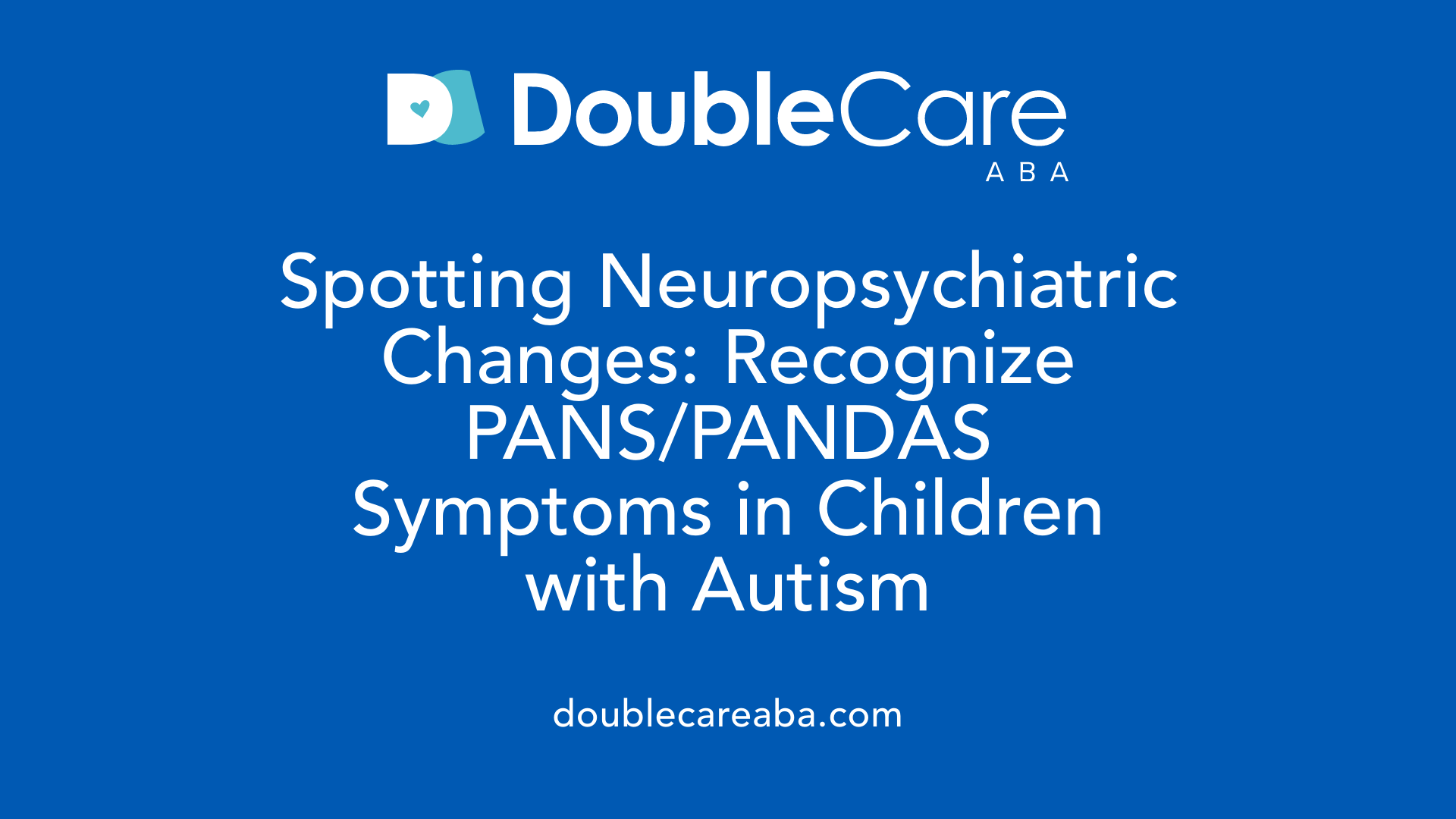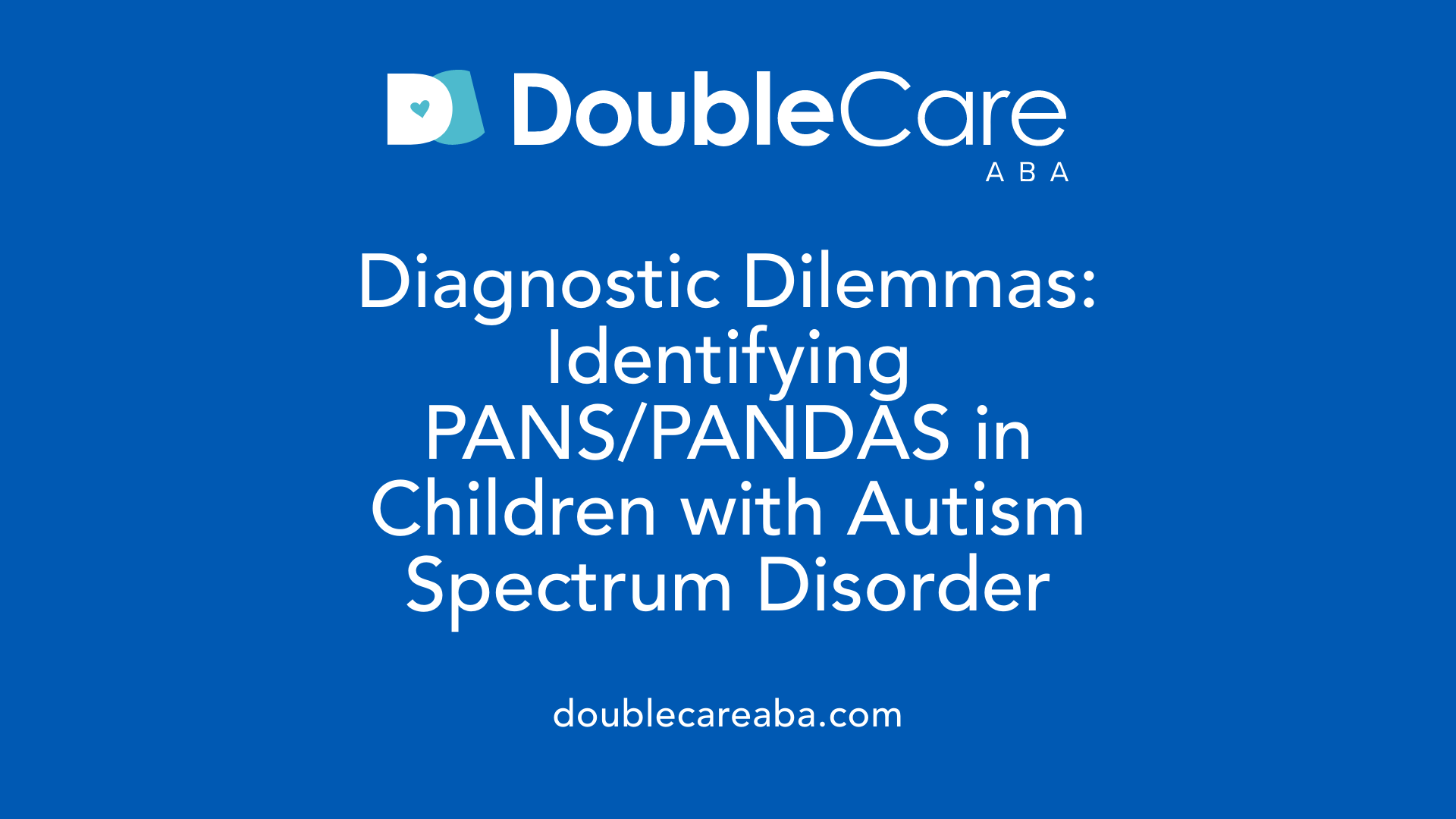Exploring Complex Neuropsychiatric Conditions in Children
This article delves into PANS/PANDAS—conditions characterized by sudden onset neuropsychiatric symptoms following infections—and their implications for children diagnosed with autism spectrum disorders (ASD). We explore underlying mechanisms, diagnostic challenges, therapeutic approaches including Applied Behavior Analysis (ABA) therapy, and the impact on families. This comprehensive discussion highlights current research and practical considerations for clinicians and caregivers navigating these overlapping conditions.
What are PANS and PANDAS?

Definition and Clinical Features of PANDAS
PANDAS stands for Pediatric Autoimmune Neuropsychiatric Disorders Associated with Streptococcal infections. It is characterized primarily by the sudden onset of obsessive-compulsive disorder (OCD) behaviors or tics in children. These symptoms emerge rapidly and dramatically, often within days to weeks after a child contracts a Group A Streptococcus infection. Besides OCD and tics, children may also experience emotional lability, separation anxiety, attention-deficit behaviors, sleep disturbances, and motor regression.
Sudden Onset and Relation to Infections
A hallmark of PANDAS is the abrupt appearance of symptoms before puberty, clearly linked in time to a streptococcal infection. This rapid development distinguishes PANDAS from other neuropsychiatric disorders which typically have a more gradual course.
Autoimmune Mechanisms Targeting the Basal Ganglia
The condition likely involves autoimmune processes where the body's immune response to streptococcal bacteria mistakenly targets the basal ganglia, a crucial area of the brain responsible for movement control and behavior regulation. This autoimmune attack leads to the neuropsychiatric symptoms seen in affected children.
Neuropsychiatric Symptoms
Children with PANDAS display a range of symptoms including intrusive thoughts and compulsive rituals (classic OCD manifestations) as well as motor and vocal tics. Emotional lability, difficulties with attention, sleep problems, and sometimes motor skill regression also contribute to the disorder’s complex clinical picture.
Overall, PANDAS represents a unique pediatric condition where infection, immunology, and psychiatry intersect, marked by distinct and sudden neuropsychiatric changes following a streptococcal infection.
Recognizing Symptoms of PANS/PANDAS in Children with Autism

How do PANS/PANDAS symptoms manifest and potentially complicate autism?
Children diagnosed with autism who develop PANS (Pediatric Acute-onset Neuropsychiatric Syndrome) or PANDAS (Pediatric Autoimmune Neuropsychiatric Disorders Associated with Streptococcal infections) may suddenly show a range of neuropsychiatric symptoms. Motor and vocal tics often appear abruptly, alongside obsessive-compulsive disorder (OCD) behaviors such as intrusive thoughts and compulsive rituals. Emotional lability and separation anxiety can also intensify, while attention deficits become more noticeable.
Additionally, these children may experience sleep disturbances and a regression in motor skills, which complicates their existing autism profile. Since some symptoms like repetitive behaviors, anxiety, and attention difficulties overlap with typical autism-related behaviors, distinguishing PANS/PANDAS can be challenging. The rapid and dramatic onset—usually within days to weeks following a streptococcal infection—helps differentiate PANS/PANDAS from autism traits that develop more gradually.
Specialized evaluation and management approaches are necessary to address this overlap effectively. Families and clinicians should be vigilant about sudden changes in a child's behavior and motor abilities to ensure timely diagnosis and treatment.
Diagnostic Challenges of PANS/PANDAS in the Context of Autism

Clinical Diagnosis Relying on Symptom Criteria
Diagnosing PANS and PANDAS is primarily clinical, based on the sudden onset of neuropsychiatric symptoms such as motor and vocal tics or obsessive-compulsive behaviors occurring shortly after a streptococcal infection. This rapid onset often happens within days to weeks, which helps clinicians correlate symptoms with prior infections.
Lack of Definitive Biomarkers
One major hurdle in diagnosis is the absence of definitive biomarkers. There are no laboratory tests that can conclusively confirm PANS/PANDAS, so healthcare providers must rely on symptom patterns and clinical judgment. This increases the risk of misdiagnosis or delayed recognition.
Importance of Establishing Temporal Relation to Infection
Establishing a temporal association between symptom onset and a streptococcal infection is crucial. Clinicians typically look for evidence of recent Group A Streptococcus infection through throat cultures or antibody titers, which supports a PANDAS diagnosis but is not always straightforward.
Exclusion of Other Causes
The diagnostic process includes ruling out other neurological or psychiatric conditions that could explain the symptoms. This ensures that other disorders such as typical OCD, Tourette’s syndrome, or autoimmune diseases are not mistaken for PANS/PANDAS.
Complications in Autism Diagnosis
Diagnosing PANS/PANDAS in children with autism spectrum disorder (ASD) presents additional challenges. Many symptoms like repetitive behaviors and anxiety overlap with baseline autism characteristics, making it difficult to detect new or acute changes. Communication difficulties in autistic children may further obscure symptom reporting, complicating timely and accurate diagnosis.
Why Is Diagnosing PANS/PANDAS Particularly Challenging, Especially in Children with Autism?
Because PANS/PANDAS relies on recognizing a sudden onset of specific symptoms after infection without clear biomarkers, the diagnosis depends heavily on clinical observation and history. In children with autism, baseline behavioral symptoms and communication challenges blur the diagnostic picture. This overlap makes it hard to distinguish between long-standing autistic behaviors and newly emerged neuropsychiatric symptoms due to PANS/PANDAS, often delaying crucial intervention.
Medical and Immunological Treatments for PANS/PANDAS

Antibiotic Therapy for Streptococcal Infections
Antibiotics are a primary treatment in PANDAS due to its association with Group A Streptococcus infections. Prompt antibiotic therapy aims to eradicate the underlying infection, potentially preventing or reducing worsening of neuropsychiatric symptoms. Common antibiotics include penicillin or azithromycin, chosen based on clinical judgment and allergy profiles.
Immunomodulatory Therapies Such as IVIG and Corticosteroids
For more severe or persistent cases, immunomodulatory treatments are used. Intravenous immunoglobulin (IVIG) therapy can help modulate immune system activity, reducing autoimmune attacks on the brain. Corticosteroids are also utilized to decrease inflammation rapidly. These therapies target the autoimmune mechanisms suspected in PANDAS.
Severity-Based Treatment Approaches
Treatment is tailored according to symptom severity. Mild cases often respond well to antibiotics and psychiatric therapies alone. For moderate to severe neuropsychiatric manifestations, a combination of antibiotics, immunomodulation, and behavioral interventions is typically necessary. This stepwise approach helps minimize side effects while addressing underlying causes.
Management of Neuropsychiatric Symptoms
In addition to addressing infections and immune responses, management includes psychiatric and behavioral therapies. Cognitive-behavioral therapy is effective for OCD and anxiety symptoms. Sleep disturbances, emotional lability, and motor tics are managed symptomatically, often requiring multidisciplinary care to improve quality of life.
The Role of Psychiatric and Behavioral Therapies in PANS/PANDAS Management
How is Cognitive-Behavioral Therapy Used in Managing PANS/PANDAS?
Cognitive-behavioral therapy (CBT) is a cornerstone in the psychiatric and behavioral treatment of PANDAS. It specifically targets obsessive-compulsive disorder (OCD) symptoms by helping children learn to recognize and modify intrusive thoughts and compulsive behaviors. Through structured sessions, CBT equips patients with coping techniques to reduce anxiety and manage rituals, leading to symptom improvement.
What Symptom Management Strategies Are Employed?
Symptom management extends beyond CBT to include behavioral interventions that help regulate emotional lability, anxiety, and attention-deficit behaviors associated with PANDAS. Therapies often incorporate relaxation techniques, exposure and response prevention, and parent training to support behavioral consistency at home.
How Are Behavioral Therapies Integrated with Medical Treatments?
Effective PANDAS management typically blends psychiatric treatments with medical approaches. While antibiotics and immunomodulatory therapies address the underlying autoimmune and infectious processes, behavioral therapies manage neuropsychiatric symptoms. Coordination between healthcare providers ensures that medications and therapy complement each other, optimizing overall outcomes.
What Benefits Do These Therapies Provide for Emotional and OCD Symptoms?
Behavioral therapies play a vital role in reducing the intensity of OCD behaviors and improving emotional regulation. Patients often experience decreased compulsive rituals, improved concentration, and stabilization of mood swings. These treatments also aid families by equipping them with tools to support their child’s emotional health and daily functioning.
| Aspect | Description | Impact |
|---|---|---|
| Cognitive-Behavioral Therapy | Structured psychological intervention focusing on OCD | Reduces compulsive behaviors and intrusive thoughts |
| Behavioral Interventions | Includes relaxation, exposure, and parent training | Manages anxiety, emotional lability, and attention deficits |
| Integration with Medical Care | Coordination with antibiotics and immunotherapy | Enhances symptom control by addressing both medical and behavioral elements |
| Emotional and OCD Symptom Relief | Improvement in mood stability and reduction in OCD severity | Leads to better quality of life for children and families |
Applied Behavior Analysis (ABA) Therapy: Foundations and Use in Autism
What is Applied Behavior Analysis (ABA) therapy and how is it used to support individuals with autism?
ABA therapy is a scientifically validated approach grounded in behavioral learning principles. It focuses on helping individuals with autism acquire new skills and reduce behaviors that interfere with daily functioning. Central to ABA is increasing positive behaviors such as communication, social interaction, and adaptive skills, while decreasing maladaptive or harmful behaviors.
Definition and Principles of ABA Therapy
At its core, ABA therapy involves understanding how behavior works, how behavior is affected by the environment, and how learning takes place. The approach uses reinforcement strategies to promote desired behaviors and decrease unwanted behaviors, relying on consistent data collection and analysis to guide treatment.
Focus on Skill Development and Behavior Modification
ABA programs prioritize teaching skills essential for independence and quality of life. This includes communication skills, social skills, self-care abilities, and academic learning. Simultaneously, strategies aim to reduce challenging behaviors by identifying triggers and replacing them with functional alternatives.
Importance of Individualized Programs
Each ABA program is tailored to the individual's unique strengths, needs, interests, and learning style. Board Certified Behavior Analysts (BCBAs) conduct assessments and design treatment plans that evolve based on ongoing progress data.
Common Techniques and Delivery Methods
ABA therapy employs multiple techniques such as discrete trial training (structured teaching in small steps), naturalistic interventions (teaching in everyday settings), task analysis (breaking down complex skills), and positive reinforcement. Delivery methods vary and can include one-on-one therapy sessions, group sessions, parent training, and classroom-based interventions.
ABA therapy's individualized, evidence-based approach makes it a cornerstone in supporting individuals with autism across a range of developmental stages and abilities.
Professional Providers of ABA Therapy and Their Qualifications
Who typically provides ABA therapy and what qualifications do they have?
Applied Behavior Analysis (ABA) therapy is primarily provided by two types of professionals: Board Certified Behavior Analysts (BCBAs) and Registered Behavior Technicians (RBTs).
Board Certified Behavior Analysts (BCBAs) roles and training
BCBAs are highly trained practitioners with advanced education in behavioral science. They are responsible for designing individualized treatment plans tailored to the needs of each client. Their role also includes overseeing therapy implementation, monitoring progress, and making data-driven adjustments to interventions. Becoming a BCBA requires completing graduate-level coursework, supervised practical experience, and passing a certification exam.
Registered Behavior Technicians (RBTs) responsibilities
RBTs are paraprofessionals who deliver ABA interventions directly under the supervision of a BCBA. They are trained to apply specific behavioral techniques and collect data during therapy sessions. RBTs complete a 40-hour training program and competency-based evaluations, ensuring they can effectively follow protocols set by the BCBA.
Importance of supervision and parental involvement
Ongoing supervision by BCBAs is crucial to maintain high-quality therapy and to tailor interventions as needed. Additionally, involving parents and caregivers helps generalize learned skills across settings and promotes consistency, enhancing treatment outcomes.
Credential verification and quality assurance measures
Verifying credentials such as BCBA certification and RBT registration ensures that providers meet professional standards. Regular audits, continuing education, and adherence to ethical guidelines further safeguard therapy quality and client safety.
Tailoring ABA Therapy to the Needs of Each Child with Autism
How is ABA therapy tailored to meet the individual needs of each person with autism?
ABA therapy is tailored based on detailed assessments carried out by Board Certified Behavior Analysts (BCBAs). These professionals conduct comprehensive evaluations to understand each child's unique behavioral patterns and skill deficits.
One crucial part of the assessment is the functional behavior assessment (FBA), which helps identify the reasons behind challenging behaviors. This understanding allows therapists to develop personalized treatment goals that focus on teaching new skills and reducing problematic behaviors.
Treatment plans are designed with clear, measurable objectives. Therapists use positive reinforcement and proactive strategies to encourage desirable behaviors while minimizing unwanted ones. Progress is closely tracked through ongoing data collection, enabling therapists to adjust interventions in real-time to better suit the child's evolving needs.
Family involvement is a cornerstone of effective ABA therapy. Parents and caregivers are trained to apply strategies in the home, promoting consistency. Moreover, therapy is often extended across multiple settings, such as school and community environments, ensuring that skills generalize beyond the clinical setting.
This comprehensive and flexible approach ensures that each child's therapy is customized to their specific strengths and challenges, maximizing their potential for meaningful growth and independence.
Typical Duration and Frequency of ABA Therapy Sessions for Optimal Results
What is the typical duration and frequency of ABA therapy sessions?
Applied Behavior Analysis (ABA) therapy generally extends over a period of 3 to 5 years to achieve significant improvements. During this time, children typically participate in sessions ranging from 10 to 40 hours per week. The frequency and length of these sessions often vary according to factors such as the child’s age, severity of symptoms, and specific individual goals.
Sessions can be scheduled 2 to 5 times per week, with each lasting anywhere from 3 to 7 hours. This early, intensive intervention approach has been shown to produce better outcomes in skill acquisition and behavior management.
The therapy plan is not static; continuous assessment is crucial for monitoring progress. Regular evaluations help therapists adjust the intensity and duration of sessions as needed. Modifications based on these assessments ensure that the child receives the most effective and individualized intervention possible, and also help determine the appropriate time to reduce or conclude therapy.
Impact on Families and Support Resources
What emotional and logistical challenges do families face?
Families dealing with PANDAS encounter substantial emotional stress due to the sudden and dramatic onset of their child's symptoms. The unpredictability of symptom flare-ups, including tics and obsessive-compulsive behaviors, creates a difficult home environment. Logistically, parents must manage frequent medical appointments, treatments ranging from antibiotics to immunotherapies, and disruptions to schooling and daily routines.
Why are support groups and educational materials important?
Support groups provide families with community connections, sharing experiences and coping strategies. Educational resources help parents understand complex symptoms and treatment options, enabling informed decision-making and reducing feelings of isolation.
How do multidisciplinary care teams aid families?
Coordinated care involving pediatricians, psychiatrists, neurologists, and therapists ensures comprehensive management tailored to the child's needs. This team approach simplifies treatment planning and monitoring, alleviating some of the families' burdens.
What advocacy and empowerment strategies assist caregivers?
Empowering caregivers through education, communication skills, and advocacy training helps them navigate healthcare systems and school accommodations. This proactive stance allows families to better support their child’s health and well-being.
Together, these resources and strategies help families meet the significant challenges posed by PANDAS, enhancing quality of life and long-term outcomes.
Future Directions: Research and Integrated Care for PANS/PANDAS and Autism

What are the ongoing biomarker identification efforts?
Researchers are actively searching for biomarkers that could provide objective diagnostic tools for PANS and PANDAS. Since current diagnosis relies heavily on clinical criteria and exclusion of other conditions, identifying reliable biomarkers would improve the precision and speed of diagnosis. These efforts focus on immune markers, neuroinflammatory indicators, and possible genetic signatures that may clarify the autoimmune nature of these disorders.
How are controlled intervention trials shaping treatment strategies?
Controlled clinical trials are essential for evaluating the effectiveness and safety of various treatments. For PANS and PANDAS, these trials test different interventions including antibiotics, immunomodulatory therapies like intravenous immunoglobulin (IVIG) and corticosteroids, as well as psychiatric and behavioral therapies such as cognitive-behavioral therapy. Rigorous studies help refine treatment protocols and guide individualized care plans.
Why is understanding long-term outcomes important?
Long-term research aims to track how patients with PANS and PANDAS progress over time, which is critical for prognosis and management. Understanding whether symptoms remit completely, persist, or evolve helps clinicians anticipate needs and adjust therapies accordingly. It also provides vital information to families about expectations and quality of life impacts.
What is the significance of developing multidisciplinary care models?
Given the complex and multifaceted nature of PANS and PANDAS, integrated care models that combine neurology, psychiatry, immunology, and allied health services are emerging. Multidisciplinary teams ensure comprehensive evaluation and coordinated treatment, addressing neuropsychiatric symptoms, immune factors, and family support. Such models enhance communication among providers and improve patient outcomes.
How does ongoing research improve diagnosis and therapy integration?
Continuous research fosters better understanding of underlying mechanisms, aiding earlier and more accurate diagnosis. It also informs the integration of diverse therapeutic approaches, ensuring that treatments target both infections and neuropsychiatric symptoms holistically. Ultimately, research drives progress toward personalized medicine approaches, optimizing care for children affected by PANS, PANDAS, and related conditions such as autism spectrum disorders.
Navigating Complex Needs for Better Outcomes
Children with co-occurring autism and PANS/PANDAS represent a uniquely challenging population requiring timely diagnosis, multidisciplinary treatment, and tailored behavioral interventions like ABA therapy. Advances in understanding autoimmune mechanisms, refining diagnostic criteria, and integrating medical, behavioral, and family-centered approaches promise improved outcomes. Continued research and collaboration among healthcare providers, therapists, and families are essential to support these children in reaching their full potential and enhancing quality of life.
References
- PANDAS Diagnosis & Management: A Review
- Personalized ABA Treatment Plans: How They're Crafted
- BlueSprig | ABA Therapy & Autism Treatment Centers
- How Long Does ABA Therapy Last? | ABA for Autism
- Understanding ABA Therapy Duration & Progress
- What to Consider When Looking for a Qualified ABA Provider
- Applied Behavior Analysis (ABA)
- Applied Behavior Analysis (ABA)
- The Top 10 Reasons Children With Autism Deserve ABA














